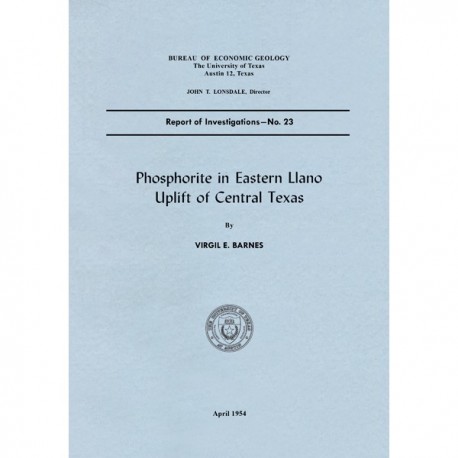Reports of Investigations
-
Books & Reports
- Reports of Investigations
- Guidebooks
- Udden Series
- Geological Circulars
- Down To Earth
- Atlases of Major Oil and Gas Reservoirs
- Texas Memorial Museum Publications
- Environmental Geologic Atlas of the Texas Coastal Zone
- Mineral Resource Circulars
- Other Reports
- Seminars and Workshops
- Handbooks
- Submerged Lands of Texas
- Symposia
- Annual Reports
- Open File Reports
-
Maps & Cross Sections
- Thematic Maps
- Miscellaneous Maps, Charts & Sections
- Geologic Atlas of Texas
- STATEMAP Project Maps
- Geologic Quadrangle Maps
- Cross Sections
- Highway Geology Map
- Energy and Mineral Resource Maps
- Shoreline Change and Other Posters
- Wilcox Group, East Texas, Geological / Hydrological Folios
- Bouguer Gravity Atlas of Texas
- River Basin Regional Studies
- Featured Maps
- Posters
- Teachers & the Public
-
Geological Society Publications
- Gulf Coast Association of Geological Societies
- Alabama Geological Society
- Austin Geological Society
- Corpus Christi Geological Society
- Houston Geological Society
- Lafayette Geological Society
- Mississippi Geological Society
- New Orleans Geological Society
- South Texas Geological Society
- GCS SEPM Publications
- Historic BEG & UT Series
Phosphorite in Eastern Llano Uplift of Central Texas
RI0023
Phosphorite in Eastern Llano Uplift of Central Texas, by V. E. Barnes. 9 p., 2 figs., 1954. Print Version.
A free, digital version of this publication can be found on: Texas ScholarWorks
This product is no longer in stock
RI0023. Phosphorite in Eastern Llano Uplift of Central Texas, by V. E. Barnes. 9 p., 2 figs., 1954. Print.
To purchase this publication as a downloadable PDF please order RI0023.
From the Introduction
A deposit of phosphorite, estimated to be 11 feet thick, was found March 26, 1952, while the writer was mapping ancient sink fillings and collapse structures within the outcrop area of the Honeycut formation south of Marble Falls, Texas. The phosphorite is exposed in a road material pit on the eastern side of a Carboniferous outlier…It rests on shale typical of that in the Barnett formation of Mississippian age and is beneath spiculitic limestone at the base of the Pennsylvanian Marble Falls limestone. Geiger counter measurements, both in the road material pit and on the opposite side of the hill at the same stratigraphic level, gave values of about 100 counts per minute, the background count being about 40 per minute.
Another outlier about 500 feet to the northeast possibly contains a similar sequence. Limestone of the type found in the phosphorite in the road material pit occurs as float about this outlier indicating that the interbedded phosphorite may also be present. A Geiger counter examination failed to reveal any abnormal readings, but the phosphorite may be present and masked by soil. These outliers probably are in structural sinks because evidence of collapse is well displayed in the road material pit where both the Honeycut and Barnett formations dip steeply inward.
The position of the phosphorite suggests that in age it is between the Barnett formation and the Marble Falls limestone. From stratigraphic position alone it could be a unit of the Barnett formation not hitherto recognized or a basal unit of the Marble Falls limestone. However, conodonts from a limestone bed in the phosphorite and from phosphorite adhering to the bed have been identified by Dr. W. H. Hass of the United States Geological Survey as predominantly Lower Pennsylvanian in age, thus eliminating the possibility that the phosphorite is a member of the Barnett formation.
Keywords: Central Texas, Llano Uplift, Barnett Formation, Marble Falls Limestone, phosphorite, minerals, Texas
Citation
Barnes, V. E., 1954, Phosphorite in Eastern Llano Uplift of Central Texas: The University of Texas at Austin, Bureau of Economic Geology, Report of Investigations No. 23, 9 p.


